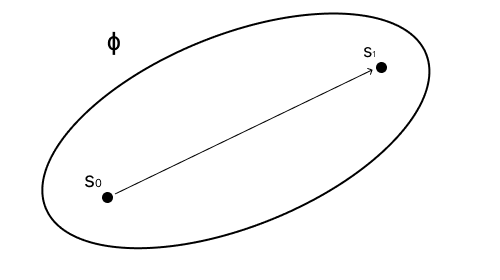Frame
The frame is a unit of Aim. In Jordan Peterson's Maps of Meaning framework [^1] frame stands for the cybernetic concept of frame of reference, although in this framework, the "frame" concept isn't only a model of perception and action, but has a broader role. It's meant to be another conceptual primitive of the phenomenological structure with which we can model the human story.
The idea of the cybernetic model is that we're always operating within some frame of reference, given by where we are — initial state — and where we want to be —final state . Where we want to be is somewhere better otherwise why bother going there?

A more general description of a frame uses a probability distribution over future states: , where the deterministic frame is the special case where collapses to a point mass at
The expected Value in that frame is now:
Just as there is right judgement, and right aim, there is such a thing as the right frame. We'll call such frames ultimate. This places a constraint on what is the right Action, i.e., what frame to adopt in any given moment. In simple terms, when it's time to sleep, you know to go to bed. When it's time to eat, you know to eat. If you violate that, and don't sleep when it's time to sleep, or eat when it's not time eat, you're aim is not optimal. It's not bound to the biological context either — it's vertically integrated into all parts of human life: there's the right job, the right friends, the right thing for everyone. This knowledge of the right thing comes from what Pirsig called dynamic Quality, "pre-intellectual cutting edge of reality, the source of all things, completely simple and always new." The individual subjects can be more or less attuned to this influx of information. In this framework we can model it by supposing there's always an ultimate frame, which directs and informs the subjective frame, seeping in the knowledge of right Action from the ineffable dimension. The ultimate frame is a kind of a theoretical ideal.
The idea that reality comes in discrete frames that we must orient to is a model. Similar to how the models we have of material world: atoms, forces, masses, velocities, even space and time aren't actual entities that exist aside from our mental projections. They are maps and not the territory. They aren't arbitrary, though, they are useful maps, because they resonate with the structure and the patterns of the territory.
It's all a matter of what patterns we want to abstract from the ground of being, and for what purpose: the material lens abstracts patterns that work well for manipulating the material world, but if it's used in a wrong context, such as understanding sociology, psychology, economics or other Value-based systems, it won't be succesful. The lens of Quality abstracts patterns that work well for understanding the human story, action and purpose.
[1]: For a more approachable introduction to Peterson's framework, I recommend watching his YouTube lectures, in particular: Story and Metastory (Part 1).